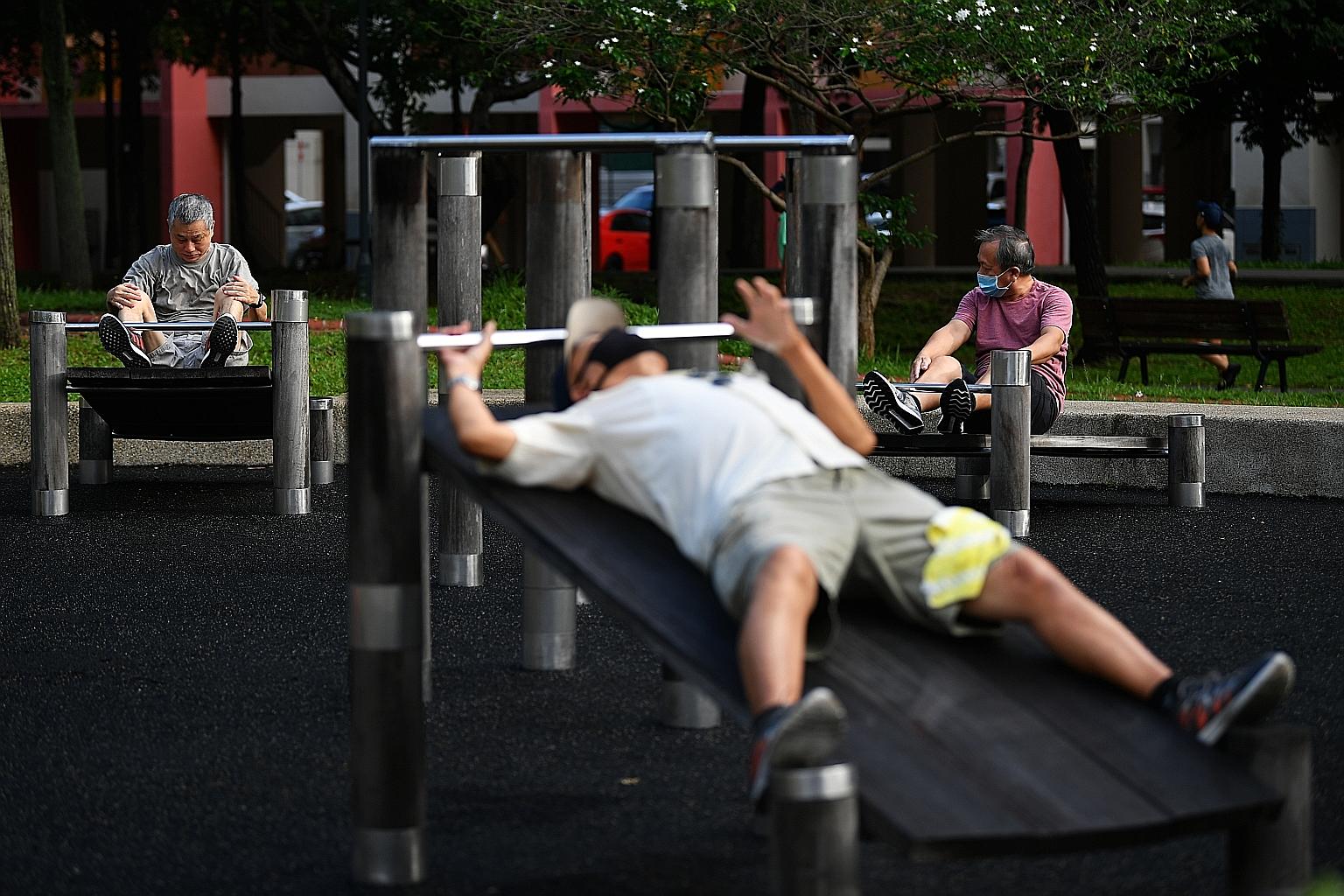Fitness
Don't rush back into sports after hiatus
Warm up, do a range of exercises and reduce your training load initially, advise experts
Sign up now: Get the biggest sports news in your inbox

Several men exercising at Tampines Central Park during the first day of phase two of the reopening of the economy on June 19. Experts say that even if sports buffs had maintained their fitness levels during the two-month circuit breaker, returning to games requires them to get their joints and muscles used to specific movements again.
ST PHOTO: LIM YAOHUI
Follow topic:
Many Singaporeans flocked eagerly to sports facilities when they reopened on June 19, after being shut for over two months due to circuit breaker measures.
But exercise researchers and sports doctors have advised those returning to sport after a lengthy time being cooped up indoors to take it slowly.
Associate Professor Fabian Lim from the Nanyang Technological University's Lee Kong Chian School of Medicine, who specialises in exercise physiology, explained: "Whether you are a recreational sports participant or professional athlete, after a period of staying away from training, you don't come back starting at the last training load or volume.
"There will be some degree of de-conditioning during that period, which means that the body is not at the same condition as when you stopped at the end of the active period."
A rough guideline, suggested by the former Singapore Sport Institute executive director, was to cut the training load for more physically demanding sports like football by 30 to 50 per cent.
For less strenuous sports such as tai chi or brisk walking, he recommended reducing the training volume by 20 to 30 per cent.
While some may have kept active during the circuit breaker, experts warned against rushing back to their normal routines.
This is because the workouts that they did during those two months would have mainly been cardiovascular exercises, as opposed to strength or skill training.
Specialist sports physician Patrick Goh, who works at Sports Medicine International at Camden Medical Centre, said: "The fact is, fitness in sports is sport-specific.
"Even if you've been running, or doing strength training at home, you might not be able to jump back into training (for) tennis or squash because these coordinations are different.
"It's good that you've maintained a baseline fitness, but you have to respect that every sport has a certain set of physical demands which you might not have been able to replicate during the lockdown."
Research conducted by Berlin-based sports scientist Dr Joel Mason on the Bundesliga's resumption on May 16 suggested that returning to training after a long lay-off could result in a higher risk of injury, with a particularly high occurrence of soft-tissue injuries like sprains or strains.
Dr Cormac O'Muircheartaigh, a sports medicine physician and medical director of Sports Medicine Lab, advised those returning to sports like football to incorporate dynamic stretching in their warm-ups so as to avoid suffering soft-tissue injuries.
Warm-ups can start with a slow jog, followed by dynamic lunges, where one progressively opens out the hips by taking a forward lunge and getting deeper into that lunge with each movement.
Other exercises that can be done are single-leg movements such as standing on one leg and bending forward, which can help to activate the hamstring.
Simple hopping exercises - like hopping forward, backwards or sideways over a line - can be done after that to get jumping and landing movements right.
When warming up for predominantly upper-body strength-based sports like badminton, tennis and swimming, Dr O'Muircheartaigh recommends doing dynamic exercises for the chest and pectorals.
TheraBand exercises to activate the muscles around the shoulder blade are also encouraged.
"For most people who've been working from home and sitting in front of a computer for eight to 10 hours a day, what tends to happen is that the back rounds off the shoulder," said Dr O'Muircheartaigh.
"If someone expects to go from that rounded kind of cramped, poor posture position into a very open sports position without opening up the shoulder, then there's a significantly higher risk of getting an acute injury to the shoulder."
As people begin playing sports again, they should also look out for signs like heavy panting and if aches or pains are taking longer than usual to go away, said Dr Lim.
Dr Goh, who was the chief medical officer for the Singapore contingent at the 2000 and 2004 Olympic Games, also stressed that people should check their weight and blood pressure before picking up sports again.
Added weight can result in more risk on weight-bearing joints, while high blood pressure increases cardiovascular risks.
He said: "When you go back, listen to your body and don't push yourself recklessly."

